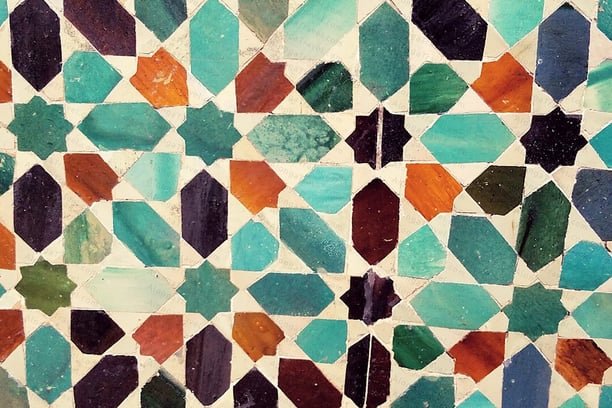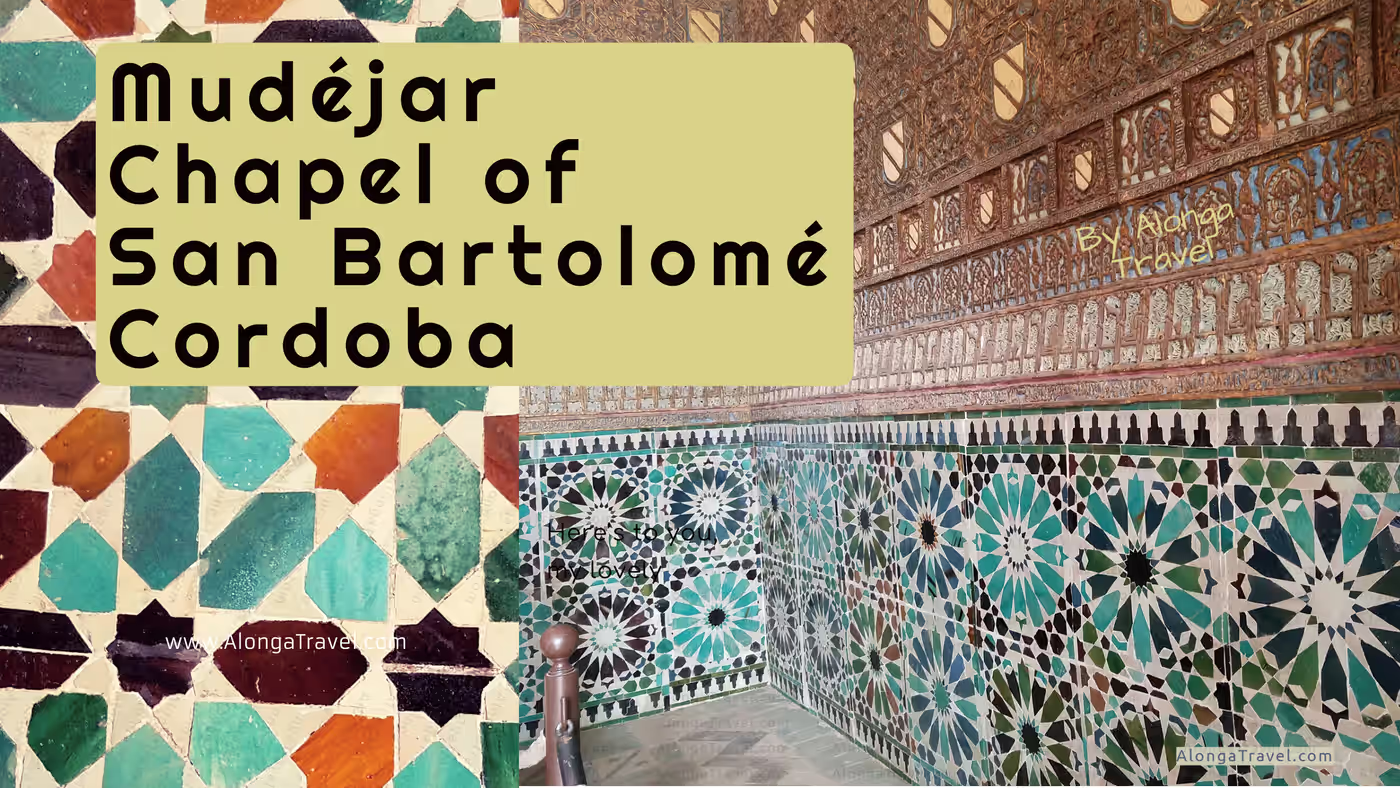Saint Bartholomew Cordoba | Mudéjar Funeral Chapel of San Bartolomé
Saint Bartholomew Chapel, or Funerary Chapel of San Bartolomé in Cordoba, is a beautiful example of Mudejar architecture in Spain and Mudéjar art in general. It’s one of a few known rooms where you can see all elements of Mudejar architecture together in one small room.
Built between the 14th and 15th centuries, this funerary chapel is located in the center of Córdoba’s historic center in Andalusia, Spain.
It also shares the fascinating multicultural history of Cordoba, Spain, being located in the former Jewish Quarter, and later transitioned into a church.
Saint Bartholomew Chapel, one of the most notable attractions in Cordoba, is not well known to visitors from other countries, so I want to share its beauty with you through my video and pictures.
Hello, I am Tatiana. I am a historical architecture addict and I am fascinated with beautiful, old buildings. I love finding the best places in Europe to go. Check out my travel tips and read my reviews of the best European destinations and city breaks. They are the results of my slow traveling!
Video of Saint Bartholomew Chapel
Watch my video from this Mudéjar Chapel of San Bartolomé, isn’t it just breathtakingly beautiful? I took it in 2018 during my first visit of Cordoba. I researched before I visited, and this museum was high up on my ‘to do’ list, right after Cordoba’s Mosque-Cathedral.
Read on to find out what you were seeing, but this Funeral Chapel is a rare case of the use of all elements of Mudejar style together in one small room.
The Jewish Quarter (La Judería) location of the Chapel
This Chapel is located in Cordoba, Spain, one of of the best destinations in Europe for architecture lovers.
The city of Cordoba has a well-preserved former Jewish quarter, Juderia, with its traditional urban layout of a medieval Islamic city.
That’s why Jewish Quarter has intersecting streets surrounded by smaller alleys. This is my favorite part of Cordoba for getting lost in the labyrinth of these alleys.
While these alleys are fun to explore, this makes the Chapel relatively hard to find, but it’s housed in today’s Faculty of Arts building. Below is the map ( it’s in the center left).

San Bartolomé Chapel History

The Chapel of San Bartolomé was built between 1390 and 1410, during the times La Juderia was still housing Jews. It is still not clear who has built the chapel, but some historical sources, including this source, suggest it was bult under guidance of Diego Fernández Abencaçin, but it’s not proven.
One thing is clear, it was built with the purpose of converting Jews from that area into Christians, because that is what was going on in Jewish quarter of Cordoba (and all over Spain). Mass conversions in Cordoba had taken place between 1391 and 1415.
In 1473 the Jewish revolt against the conversion of Córdoba happened. The Jews were eventually expelled from the Jewish quarter in 1492, and the building took on various roles over time.
The Jews were expelled from the Jewish quarter in 1492, and the building took on various roles over time.
It became a church after the expulsion of the Jews. It was time of the repopulation of the Alcázar Viejo neighborhood and the abandonment of the Jewish Quarter leading to the establishment of the Christian quarter of San Bartolomé.
The building continued to operate as a parish church until the 17th century.
From the 17th to the 20th centuries the building became Cardenal Salazar Hospital.
The Chapel of San Bartolome is a historical monument since 1931.
This Funeral Chapel was eventually restored in 1953 and 2006, to showcase its ancient magnificent Mudéjar artistry, as it was just too valuable not to share it.

Architecture of Saint Bartholomew
Saint Bartholomew Chapel’s floor plan is divided into a rectangular chapel and an atrium.
An atrium
An atrium is big open area in a house or church. It is where families (or parishioners) spend time together. It is usually beautifully decorated, and The Chapel de San Bartolomé is no exception, though since the Chapel served as a funeral chapel, the yard at the beginning had a more somber function.
The yard has unique stone pavement covering, 2 antient columns and a tree in the middle of the yard, decorated with unusual rope-like stone patterns.

The courtyard also shows Islamic influences with columns adorned in scrolls and leaves, supporting a rib-vaulted ceiling.

The courtyard entrance of the chapel is a pointed arch with Islamic decorations. Another entrance is covered by metal gates and leads outside.

There was an old authentic looking wooden bench I liked.

This crucifix in a vault in the courtyard is the remains from the church’s times.
The Funerary Chapel itself is built with sandstones. It’s a small, 9m by 5m room, and yet it’s breathtakingly beautiful.
This Mudejar room has original 15th-century flooring with glazed bricks and intricately designed socles.
It’s impossible to describe the decoration of this chapel without mentioning Mudejar style.
Mudejar style decorations
Capilla Mudéjar de San Bartolomé is a great example of Mudéjar art, the fusion of Islamic and Christian architectural styles. As was explained in that post on Alonga Travel, the style reflects the diverse society of medieval Spain, with many nations living together, and is characterized by intricate decorations and architectural details.
Follow the link to read my post about this fun style in more details.
In this small Chapel, you can see many different elements of this style all put together. There are Mudejar style vaults, arches, intricate wood carvings, Moorish tiles, and other Mudejar elements.
It’s possible that there is no other example of so many elements of Mudejar architecture together, which makes San Bartolome Chapel very special, indeed.

Chapel’s interior with Stellar Patterns of Yeseria Plasterwork.
The Chapel itself is beautifully and exquisitely decorated.

The room has a beautiful arched niche decorated with tiles.

The chapel room also has beautiful light fixtures that hang from the vaulted ceiling.
The ceiling itself consist of a few interlaced arches. You can see remnants of red frescoes at the ceiling’s base.

The plasterwork on the walls displays a variety of Mudéjar styles, including lacería, ataurique, and inscriptions in Kufic and nasjí scripts.
Here is this laceria, the intricate plasterwork and incredible tilework, with geometric and vegetal motifs and heraldic emblems.
Yesería (laceria)
Yesería is the intricate plasterwork that is a hallmark of Islamic architecture. In Spain, in particular, it is used in context of Islamic and Mudejar architecture in Spain.
This decorative art form includes carved or molded stucco and plaster. It usually features geometric patterns, arabesques, and calligraphic motifs.
In Funerary Chapel of San Bartolomé in Cordoba, yeseria refers to the plasterwork that covers the interior of the chapel.
Share this on Facebook

Tiles
Along the base of the walls in Saint Bartholomew chapel’s mosaic Mudejar tiles, varying in shades of blue and green, create an unbelievably beautiful scene. I gasped when I entered the room!
Different walls have different tile motives.
Some tiles have the same Nasrid tiles motives, seen in Nasrid Palaces in Alhambra in Granada, Spain. This is no wonder, because both cities are relatively close to each other in Andalusia, Spain.
Additionally, a restoration in 1935 revealed a collection of Nasrid tiles that is now housed in the Museo Arqueológico y Etnológico de Córdoba.

Practical information
Be careful about the opening hours, as it doesn’t open regularly. And it is not (always) opened on Monday. In fact, I had to reschedule my plans in Cordoba to make sure I’ll be able to visit (my original full day of visiting was a Monday).
But some months it is open on Monday! I know.:)
It also often opened just for a few hours – but you can check easily online on Saint Bartholomew Chapel in Cordoba website.
It’s was free to enter if you’re from Spain, but I believe it has changed. I had to pay around €2 as an American. But most days, it’s only €1.50. I know!:)
I hope I helped you decide if you want to visit this incredible Chapel.
Let’s connect on social media!
Found this post helpful? Please, consider supporting my work and the website maintenance cost, thank you!
Subscribe to my periodic newsletter for my new posts. New here? Visit my main Alonga Travel page.

